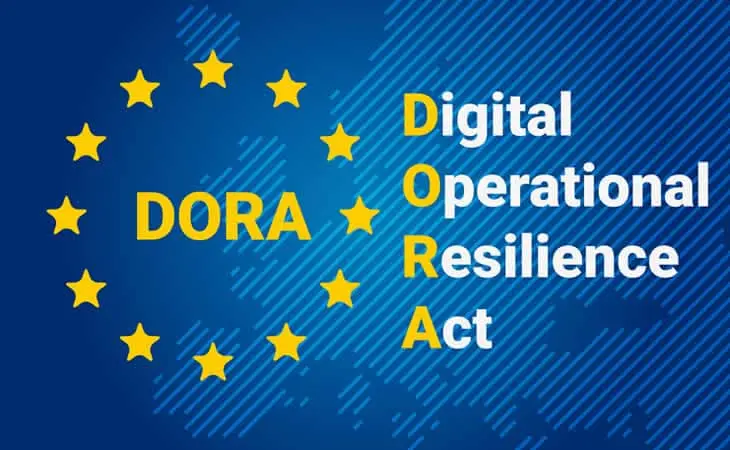DORA (Digital Operational Resilience Act)
Discover how Brainframe can help you to implement and manage your DORA compliance efforts effectively

DORA compliance made easy
The Digital Operational Resilience Act (DORA) sets a new standard for financial institutions, ensuring robust security and operational resilience in the face of digital threats. Brainframe is designed to simplify your journey to DORA compliance by providing a comprehensive Information Security Management System (ISMS) that aligns with DORA’s requirements. Stay ahead of regulations with streamlined risk management, real-time monitoring, document management, all in one platform. Ensure your organization’s resilience and compliance effortlessly.
Who is affected?
Investment and Insurance Entities
Covers investment firms and
both insurance and reinsurance companies,
which focus on asset management,
financial products, and risk coverage.
Market and Infrastructure Providers
This group comprises central counterparties (CCPs),
central securities depositories (CSDs),
trading venues, trade repositories,
and data reporting service providers
that support the financial market’s infrastructure.
Banking and Payment Institutions
This category includes banks, payment service
providers, and electronic money institutions that
manage financial transactions and customer
accounts

Risk Management
DORA's risk management requirements mandate that financial institutions establish comprehensive frameworks to identify, assess, and mitigate digital risks across all operations. These frameworks must address a broad spectrum of risks, including cybersecurity threats, third-party dependencies, and operational vulnerabilities, with direct involvement from management.
Incident Management
DORA's incident management requirements ensure that financial institutions have robust processes in place to detect, respond to, and recover from ICT-related incidents swiftly and effectively. These processes must include clear communication protocols, incident escalation procedures, and regular testing to maintain operational resilience.
Resilience Testing
DORA's resilience testing requirements mandate that financial institutions regularly test their ICT systems and processes to ensure they can withstand and recover from disruptions. These tests must cover a range of scenarios, including cyberattacks and operational failures, and should involve both internal systems and third-party providers.
TPRM
DORA's third-party risk management requirements emphasize the need for financial institutions to assess and manage the risks posed by their ICT service providers. Institutions must implement robust due diligence processes, continuously monitor third- (and fourth- and fifth-) party performance, and ensure that contracts include provisions for security and resilience.
DORA Best Practices
Understand scope and requirements
Understanding the scope and requirements of DORA is the critical first step in achieving compliance. This involves identifying how DORA applies to your organization, including the specific financial services or ICT services subject to regulation.
Initial risk assessment
This involves identifying and evaluating potential ICT-related risks across your organization, including cyber threats, operational vulnerabilities, and third-party dependencies. By assessing these risks early, you can prioritize mitigation efforts, assign appropriate controls, and establish a foundation for building a resilient risk management framework in line with DORA’s requirements.
Risk management framework
This framework should outline strategies, policies, and procedures for identifying, assessing, and mitigating ICT risks. It must include clearly defined roles and responsibilities, controls assigned to specific risks, and processes for continuous monitoring and review, to ensure your organization can proactively manage risks and maintain operational resilience in compliance with DORA.
Policies and procedures
Establish policies that cover information security, network management, access control, incident response, and resilience strategies, ensuring they align with regulatory standards. Clear procedures must be established for implementing these policies, with defined roles, responsibilities, and approval processes. This structured approach ensures consistency, accountability, and compliance throughout your organization.
Implement controls and mitigations
This involves putting in place the necessary technical and organizational controls to address identified risks, such as cybersecurity measures, access management, and incident response protocols. Each control should be aligned with the risk management framework, ensuring that potential vulnerabilities are proactively mitigated. Effective implementation of these controls safeguards your ICT assets and enhances operational resilience.
Establish an incident response process
This process should define clear procedures for detecting, reporting, and managing ICT-related incidents, including roles and responsibilities for response teams. It must include guidelines for communication, escalation, and recovery to ensure swift and coordinated action during disruptions. A well-defined incident response process helps minimize impact and supports organizational resilience.
Document and record
Documenting all aspects of your DORA compliance efforts is crucial for transparency and accountability. This includes recording assets, processes, policies, procedures, risk assessments, controls, tests, and incidents in detail. Proper documentation ensures that all actions and decisions are traceable, facilitates audits and reviews, and provides a clear reference for ongoing compliance and continuous improvement efforts.
Continuous improvement
Regularly review and update your risk management framework, policies, and controls based on performance metrics, audit findings, and emerging threats. By incorporating feedback, monitoring effectiveness, and adapting to changes in the regulatory landscape, you ensure that your risk management practices remain robust and effective over time.
Brainframe overview
Asset Management
Brainframe enables you to maintain a comprehensive inventory of your assets, seamlessly mapping them to the processes they support. It allows you to assign a criticality level to each asset, ensuring you can effectively prioritize and manage your organization's key resources.
Risk Management
Brainframe allows you to define your risks for each asset or process, determing their criticality level, plan for and prioritize their mitigation, and offers a comprehensive view to track all your risks in a centralized dashboard.
Policy Management
Leverage Brainframe's comprehensive templates to efficiently develop the policies and procedures mandated by DORA. Assign specific roles and responsibilities to management, ensuring their active involvement and accountability in the policy creation and decision-making process.
Maturity Management
Map your controls to their requirements and track your compliance frameworks' maturity level. Thanks to the deep integration with the task manager, you can show your progress and improve your audit efficiency.
Achieve DORA compliance with Brainframe
Self-hosted solution
Brainframe can be seamlessly implemented on your on-premises infrastructure, providing full control over your data and systems. This deployment option ensures compliance with internal security policies and regulatory requirements, while offering the same powerful features and capabilities of Brainframe’s cloud-based solutions. With on-premises implementation, you can tailor the platform to your unique environment, ensuring optimal performance and integration with existing infrastructure.
Cloud solution
Brainframe is available as a cloud-based solution, offering flexibility and scalability without the need for complex infrastructure management. This deployment option ensures quick implementation and automatic updates, while maintaining the highest levels of security and compliance. With Brainframe in the cloud, you can access the platform from anywhere, enabling seamless collaboration and ensuring that your organization stays resilient and up-to-date with minimal overhead.
Discover our solution for each of these DORA requirements for a better overview on how Brainframe can help you :
DORA requirement | Brainframe Solution |
Article 5 : Governance and organisation This section outlines the responsibilities of the management body of financial entities with regards to managing ICT risk, including the creation of policies, definition of roles and responsibilities, and establishment of governance arrangements. |
|
Article 6 : Risk Management framework Article 6 defines the structure of the required frameworks to be implemented for DORA. They must include strategies, policies, procedures, ICT protocols and tools that mitigate risks and protect ICT assets. It requires controls to be assigned to risks, and the framework must be documented and regularly reviewed. It must include a resilience strategy. |
|
Article 8 : Identification Financial entities must identify, classify and properly document ICT business functions, information assets, roles and dependencies in order to mitigate ICT risk, and maintain an inventory of all their assets and processes. |
|
Article 9 : Protection & Prevention DORA sets out measures related to the development and documentation of policies on information security, network infrastructure management, access control, and authentication mechanisms, along with policies on patching and updating. These policies must be approved by management. |
|
Article 10 : Detection DORA requires to put in place mechanisms to promptly detect anomalous activities, regular testing, devoting sufficient resources and capabilities to monitoring user activity and the occurrence of ICT anomalies. |
|
Article 11 : Response & Recovery To ensure the continuity of their operations, financial entities must put in place a comprehensive ICT business continuity policy, associated ICT response and recovery plans, and ICT business continuity plans. They must conduct yearly BIAs and keep records of activities during disruptions. |
|
Article 12 : Backup policies and procedures, restoration and recovery procedures and methods Article 12 aims to ensure that ICT systems and data can be restored with minimal disruption and loss in the event of an incident by requiring financial entities to develop and document backup and restoration policies and procedures, which are to be tested regularly. |
|
Article 13 : Learning & Evolving Financial entities must have in place ICT security awareness training programmes for staff, and they must update their risk management framework regularly to stay up to date with emerging cyber threats. |
|
Article 14 : Communication Financial entities must have in place crisis communication plans for the disclosure of major ICT-related incidents to the clients, and, when appropriate, to the public. |
|
DORA requirement | Brainframe Solution |
Article 17 : ICT-related incident management process DORA requires you to establish a process for ICT-related incident management, including establishing early warning indicators, procedures for identifying, tracking, logging and classifying ICT-related incidents, assigning roles and responsibilities for incidents, plans for communication and notification, and ICT-related incident response procedures. Major ICT-related incidents must be reported to management. |
|
Article 18 : Classification of ICT-related incidents and cyber threats Article 18 requires financial institutions to classify ICT-related incidents based on criteria such as the number of affected clients, the geographical spread, the amount or number of transactions affected, the duration of the incident and the data losses that the incident entails. |
|
Article 19 : Reporting of major ICT-related incidents and voluntary notification of significant cyber threats Financial entities must report major ICT-related incidents to the relevant competent authority within a certain time frame, which can be as little as four hours after the detection of the incident. |
|
DORA requirement | Brainframe Solution |
Article 24 : General requirements for the performance of digital operational resilience testing Financial entities must establish and maintain a sound and comprehensive risk-based digital operational resilience testing programme, including a range of assessments, tests, methodologies and tools. |
|
Article 25 : Testing of ICT tools and systems DORA requires you to perform tests adapted to relevant asset including vulnerability assessments and scans, open source analysis, network security assessments, gap analyses, physical security reviews, questionnaires, scanning solutions, source code reviews, scenario tests, compatibility tests, performance tests, end-to-end tests, and penetration testing. |
|
Article 26 : Advanced testing of ICT tools, systems and processes based on TLPT Article 26 requires that critical or important functions of the financial entity must be tested using threat-lead penetration testing, and must involve ICT third-party service providers contracted by the financial entity. |
|
DORA requirement | Brainframe Solution |
Article 28 : General principles Financial entities must manage third-party ICT risk as an integral component of their ICT risk management framework. Financial entities must adopt and regularly review a strategy on ICT third-party risk and update a register of information related to all contractual arrangements with ICT third-party service providers. |
|
Article 30 : Key contractual provision The contractual arrangements on the use of ICT services must include information such as the description of functions, locations for data processing, provisions for data security, service levels, availability of data and assistance with ICT incidents as well as termination rights and conditions. |
|
DORA requirement | Brainframe Solution |
Article 45 : Information-sharing arrangements on cyber threat information and intelligence This is an optional section encouraging financial institutions to exchange amongst themselves cyber threat information and intelligence, with the goal of enhancing digital resilience in the financial sector. |
|
Audit trail
Brainframe ensures a comprehensive and automated audit trail by recording all actions, changes, and updates made within the system. It tracks user activities, policy modifications, risk assessments, and compliance measures, providing clear, time-stamped documentation. This detailed audit trail not only simplifies internal and external audits but also ensures transparency, accountability, and alignment with regulatory requirements like DORA
KPIs
Brainframe enables comprehensive KPI monitoring, providing a centralized dashboard for tracking key performance metrics across departments or product lines. It offers real-time insights to ensure clear visibility into progress and performance. This streamlined approach facilitates data-driven decision-making and helps maintain alignment with organizational goals and compliance requirements
Integrations
Brainframe supports seamless integrations with your existing systems (SharePoint, JIRA, Monday.com,...) allowing you to easily import documents and records. This ensures a smooth transition by centralizing all relevant files within the platform, reducing manual work, and maintaining consistency. By integrating your current document workflows, the software helps streamline processes and enhance efficiency across your organization.
Interested in knowing more?
Book a call to find out more on how we can help you achieve and manage your compliance with DORA

Start for free now!
Streamline your GRC work using our all-in-one management solution and get access to our network of local specialists